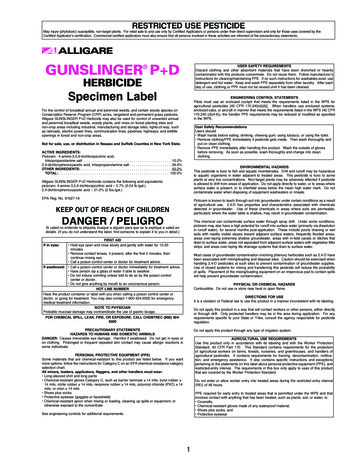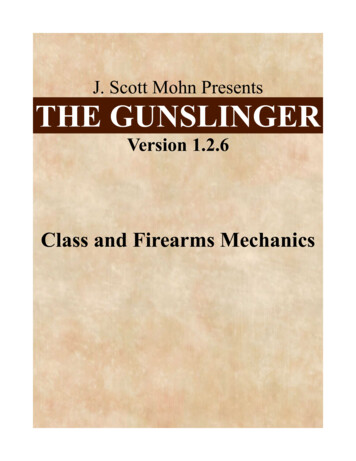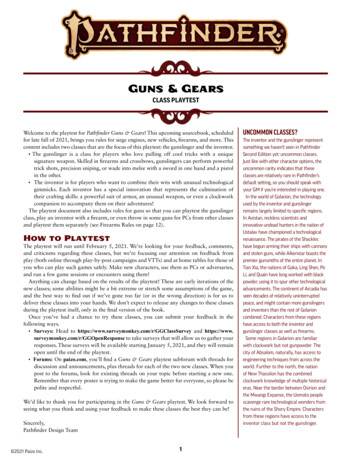
Transcription
RESTRICTED USE PESTICIDEMay injure (phytotoxic) susceptible, non-target plants. For retail sale to and use only by Certified Applicators or persons under their direct supervision and only for those uses covered by theCertified Applicator’s certification. Commercial certified applicators must also ensure that all persons involved in these activities are informed of the precautionary statements.GUNSLINGER P D USER SAFETY REQUIREMENTSDiscard clothing and other absorbent materials that have been drenched or heavilycontaminated with this products concentrate. Do not reuse them. Follow manufacturer’sinstructions for cleaning/maintaining PPE. If no such instructions for washables exist, usedetergent and hot water. Keep and wash PPE separately from other laundry. After eachday of use, clothing or PPE must not be reused until it has been cleaned.HERBICIDESpecimen LabelENGINEERING CONTROL STATEMENTSPilots must use an enclosed cockpit that meets the requirements listed in the WPS foragricultural pesticides [40 CFR 170.240(d)(6)]. When handlers use enclosed systems,enclosed cabs, or aircraft in manner that meets the requirements listed in the WPS (40 CFR170.240 (d)(4-6)), the handler PPE requirements may be reduced or modified as specifiedin the WPS.For the control of broadleaf annual and perennial weeds, and certain woody species onConservation Reserve Program (CRP) acres, rangeland and permanent grass pastures.Alligare GUNSLINGER P D Herbicide may also be used for control of unwanted annualand perennial broadleaf weeds, woody plants, and vines on forest planting sites andnon-crop areas including industrial, manufacturing and storage sites; rights-of-way, suchas railroads, electric power lines, communication lines, pipelines, highways; and wildlifeopenings in forest and non-crop areas.User Safety RecommendationsUsers should: Wash hands before eating, drinking, chewing gum, using tobacco, or using the toilet. Remove clothing/PPE immediately if pesticide gets inside. Then wash thoroughly andput on clean clothing. Remove PPE immediately after handling this product. Wash the outside of glovesbefore removing. As soon as possible, wash thoroughly and change into cleanclothing.Not for sale, use, or distribution in Nassau and Suffolk Counties in New York State.ACTIVE INGREDIENTS:Picloram: 4-amino-3,5,6-trichloropicolinic acid,triisopropanolamine salt . . . . . . . . . . . . . . . . . . . . . . . . . . . . . . . . . . . . . . . . . . . . . . 10.2%2,4-dichlorophenoxyacetic acid, triisopropanolamine salt . . . . . . . . . . . . . . . . . . . . . . 39.6%OTHER INGREDIENTS: . . . . . . . . . . . . . . . . . . . . . . . . . . . . . . . . . . . . . . . . . . . . . . . 50.2%TOTAL: . . . . . . . . . . . . . . . . . . . . . . . . . . . . . . . . . . . . . . . . . . . . . . . . . . . . . . . . . 100.0%ENVIRONMENTAL HAZARDSThis pesticide is toxic to fish and aquatic invertebrates. Drift and runoff may be hazardousto aquatic organisms in water adjacent to treated areas. This pesticide is toxic to someplants at very low concentrations. Non-target plants may be adversely affected if pesticideis allowed to drift from areas of application. Do not apply directly to water, or to areas wheresurface water is present, or to intertidal areas below the mean high water mark. Do notcontaminate water when disposing of equipment washwaters or rinsate.Alligare GUNSLINGER P D Herbicide contains the following acid equivalents:picloram: 4-amino-3,5,6-trichloropicolinic acid – 5.7% (0.54 lb./gal.)2,4-dichlorophenoxyacetic acid – 21.2% (2 lbs./gal.)EPA Reg. No. 81927-16Picloram is known to leach through soil into groundwater under certain conditions as a resultof agricultural use. 2,4-D has properties and characteristics associated with chemicalsdetected in groundwater. Use of these chemicals in areas where soils are permeable,particularly where the water table is shallow, may result in groundwater contamination.KEEP OUT OF REACH OF CHILDRENDANGER / PELIGROThis chemical can contaminate surface water through spray drift. Under some conditions,picloram may also have a high potential for runoff into surface water (primarily via dissolutionin runoff water), for several months post-application. These include poorly draining or wetsoils with readily visible slopes toward adjacent surface waters, frequently flooded areas,areas over-laying extremely shallow groundwater, areas with in-field canals or ditches thatdrain to surface water, areas not separated from adjacent surface waters with vegetative filterstrips, and areas over-laying tile drainage systems that drain to surface water.Si usted no entiende la etiqueta, busque a alguien para que se la explique a usted endetalle. (If you do not understand the label, find someone to explain it to you in detail.)FIRST AID Hold eye open and rinse slowly and gently with water for 15-20minutes. Remove contact lenses, if present, after the first 5 minutes, thencontinue rinsing eye. Call a poison control center or doctor for treatment advice.If swallowed: Call a poison control center or doctor immediately for treatment advice. Have person sip a glass of water if able to swallow. Do not induce vomiting unless told to do so by the poison controlcenter or doctor. Do not give anything by mouth to an unconscious person.HOT LINE NUMBERHave the product container or label with you when calling a poison control center ordoctor, or going for treatment. You may also contact 1-800-424-9300 for emergencymedical treatment information.NOTE TO PHYSICIANProbable mucosal damage may contraindicate the use of gastric lavage.If in eyes:Most cases of groundwater contamination involving phenoxy herbicides such as 2,4-D havebeen associated with mixing/loading and disposal sites. Caution should be exercised whenhandling 2,4-D pesticides at such sites to prevent contamination of groundwater supplies.Use of closed systems for mixing and transferring this pesticide will reduce the probabilityof spills. Placement of the mixing/loading equipment on an impervious pad to contain spillswill help prevent groundwater contamination.PHYSICAL OR CHEMICAL HAZARDSCombustible. Do not use or store near heat or open flame.DIRECTIONS FOR USEIt is a violation of Federal law to use this product in a manner inconsistent with its labeling.Do not apply this product in a way that will contact workers or other persons, either directlyor through drift. Only protected handlers may be in the area during application. For anyrequirements specific to your State or Tribe, consult the agency responsible for pesticideregulation.FOR CHEMICAL SPILL, LEAK, FIRE, OR EXPOSURE, CALL CHEMTREC (800) 4249300PRECAUTIONARY STATEMENTSHAZARDS TO HUMANS AND DOMESTIC ANIMALSDANGER: Causes irreversible eye damage. Harmful if swallowed. Do not get in eyes oron clothing. Prolonged or frequent repeated skin contact may cause allergic reactions insome individuals.Do not apply this product through any type of irrigation system.AGRICULTURAL USE REQUIREMENTSUse this product only in accordance with its labeling and with the Worker ProtectionStandard, 40 CFR Part 170. This Standard contains requirements for the protectionof agricultural workers on farms, forests, nurseries, and greenhouses, and handlers ofagricultural pesticides. It contains requirements for training, decontamination, notification, and emergency assistance. It also contains specific instructions and exceptionspertaining to the statements on this label about personal protective equipment (PPE), andrestricted-entry interval. The requirements in this box only apply to uses of this productthat are covered by the Worker Protection Standard.PERSONAL PROTECTIVE EQUIPMENT (PPE)Some materials that are chemical-resistant to this product are listed below. If you wantmore options, follow the instructions for Category C on an EPA chemical-resistance categoryselection chart.All mixers, loaders, applicators, flaggers, and other handlers must wear: Long-sleeved shirt and long pants Chemical-resistant gloves Category C, such as barrier laminate 14 mils, butyl rubber 14 mils, nitrile rubber 14 mils, neoprene rubber 14 mils, polyvinyl chloride (PVC) 14mils, or viton 14 mils Shoes plus socks Protective eyewear (goggles or faceshield) Chemical-resistant apron when mixing or loading, cleaning up spills or equipment, orotherwise exposed to the concentrateDo not enter or allow worker entry into treated areas during the restricted entry interval(REI) of 48 hours.PPE required for early entry to treated areas that is permitted under the WPS and thatinvolves contact with anything that has been treated, such as plants, soil, or water, is: Coveralls, Chemical-resistant gloves made of any waterproof material, Shoes plus socks, and Protective eyewearSee engineering controls for additional requirements.1
Specimen LabelGUNSLINGER P DDo not use hay or grass from treated areas or manure from animals being fed treated forageor hay for composting or mulching of desirable, susceptible broadleaf plants.NON-AGRICULTURAL USE REQUIREMENTSThe requirements in this box apply to uses of this product that are NOT within the scopeof the Worker Protection Standard for Agricultural Pesticides (40 CFR Part 170). TheWPS applies when this product is used to produce agricultural plants on farms, forests,nurseries, or greenhouses.Do not contaminate water intended for irrigation or domestic purposes. Do not treat or allowspray drift or run-off to fall onto banks or bottoms of irrigation ditches, either dry or containingwater, or other channels that carry water that may be used for irrigation or domestic purposes. Do not apply to snow or frozen ground.Entry Restrictions for Non-WPS Uses: Do not enter or allow people (or pets) to entertreated area until sprays have dried.Do not apply or permit Alligare GUNSLINGER P D Herbicide or sprays containing AlligareGUNSLINGER P D Herbicide to contact crops or other desirable broadleaf plants, includingbut not limited to alfalfa, beans, cotton, grapes, melons, peas, potatoes, safflower, soybeans, sugar beets, sunflower, tobacco, tomatoes, and other vegetable crops, flowers, fruitplants, ornamentals and shade trees.INFORMATIONAlligare GUNSLINGER P D Herbicide is a water soluble liquid product containing picloramand 2,4-D. Use Alligare GUNSLINGER P D Herbicide in permanent grass pastures andrangeland to selectively control many annual, biennial, and perennial broadleaf weeds andwoody species listed on this label. Alligare GUNSLINGER P D Herbicide may also be usedfor control of unwanted annual and perennial broadleaf weeds and woody plants and vineson forest planting sites and non-crop areas including industrial, manufacturing and storagesites; rights-of-way, such as railroads, electric power lines, communication lines, pipelines,highways; and wildlife openings in forest and non-crop areas.Do not use Alligare GUNSLINGER P D Herbicide on sub-irrigated land.Avoid injury to newly planted conifers. Conifer plantings vary. Pines planted sooner than6 months after treatment with Alligare GUNSLINGER P D Herbicide may be injured in theSouth or west of the Cascade Mountains. Other conifers, west of the Cascade Mountains,may be injured if planted sooner than 8 to 9 months after treatment. For all conifers, thewaiting period between treatment and planting should be 11 to 12 months in the areabetween the Cascade and Rocky Mountains and 8 to 9 months in the Lake States andNortheastern U.S.Herbicidal effects of Alligare GUNSLINGER P D Herbicide occur primarily from uptake byplant foliage and translocation throughout the plant, however, secondary herbicidal activitymay occur from soil uptake of picloram. Broadleaf plants can be killed or damaged by verysmall amounts of Alligare GUNSLINGER P D Herbicide. To prevent damage to crops andother desirable plants, carefully follow all directions and precautions.Pasture, Rangeland and CRP Application Restrictions Do not cut forage for hay within 30 days of application. Do not exceed 7.4 pints (0.5 lb ae picloram)/acre per broadcast application. Do not exceed 14.8 pints (1.0 lb ae picloram)/acre per year. For susceptible annual and biennial broadleaf weeds, use 4 pints (1.0 lb ae 2,4-D)/acreper application. For moderately susceptible biennial and perennial broadleaf weeds, use 4-7.4 pints (1.01.84 lb ae 2,4-D)/acre per application. For difficult to control weeds and woody plants, use 7.4 pints/acre per application. Spot Treatment: Do not exceed 7.4 pints (2 lb ae 2,4-D; 1.0 lb ae picloram)/acre, with nomore than 50% of an acre being treated. Spot treatments and broadcast treatments can be applied during the same growingseason only if the total amount applied does not exceed 14.8 pints (1.0 lb ae picloram)/acre per growing season. Minimum of 30 days between applications. Maximum of two applications per year. If grass is to be cut for hay, Agricultural Use Requirements for the Worker ProtectionStandard are applicable. For program lands, such as Conservation Reserve Program, consult program rules todetermine whether grass or hay may be used. The more restrictive requirements of theprogram rules or this label must be followed.PRECAUTIONS AND RESTRICTIONSObserve any special use and application restrictions and limitations, including method ofapplication and permissible areas of use as required by state or local regulations. Whenused in tank mix combination with other products, follow all applicable use directions, precautions, restrictions, and limitations on the labels of each product used.Not for sale, use, or distribution in Nassau and Suffolk Counties in New York State.Application Rate Ranges: Use higher rates in areas with dense weed populations or forlonger residual weed control. For best results, the lower rate should be used only whenenvironmental conditions are favorable for plant growth and when the plants are in the recommended growth stage. Compared to results obtained with the higher rate, a lower ratemay be slower to show activity, provide a lower level of control, and may require retreatment.Maximum Use Rates:Pasture and Rangeland: See rate restrictions under the section Pasture, Rangelandand CRP Application Restrictions.Rights-of-Way and other Non-crop Areas: Do not exceed 7.4 quarts (4.0 lb ae 2,4-D)per acre of this product per annual growing season.SPRAY DRIFT MANAGEMENTSpray Drift ManagementAVOIDING SPRAY DRIFT AT THE APPLICATION SITE IS THE RESPONSIBILITY OF THEAPPLICATOR. The interaction of many equipment-and-weather-related factors determinethe potential for spray drift. The applicator is responsible for considering all these factorswhen making decisions.Forest Sites: No more than 7.4 quarts (1.0 lb ae picloram) per acre may be applied withina period of 2 annual growing seasons.Grazing Restrictions: There are no grazing restrictions for non-lactating dairy animals orother livestock including horses, sheep, goats, and other animals in the treatment area. Donot allow lactating dairy animals to graze treated areas within 7 days after application. Donot harvest grass cut for hay from treated areas for 30 days after application. Meat animalsmust be withdrawn from treated forage at least 3 days before slaughter.The following drift management requirements must be followed to avoid off-target movementfrom aerial applications to agricultural field crops. These requirements do not apply to forestry applications, public health uses or to applications using dry formulations.Do not rotate to crops intended for food or feed use on areas treated with this product, otherthan range or pasture grasses, rye, forage sorghum, sudangrass, wheat, barley or oats notunderseeded with a legume.1. The distance of the outer most nozzles on the boom must not exceed ¾ the length ofthe wingspan or rotor.2. Nozzles must always point backward parallel with the air stream and never be pointeddownwards more than 45 degrees.Do not move treated soil, or use treated soil for growing other plants until soil residues of picloram are no longer detectable as indicated by an adequately sensitive bioassay or chemical test.Where states have more stringent regulations, they should be observed.Do not apply Alligare GUNSLINGER P D Herbicide in residential areas or near ornamentaltrees and shrubs. Untreated trees can be affected by root uptake of the herbicide throughmovement into the top soil or by excretion of the product from the roots of nearby treatedtrees. Do not apply Alligare GUNSLINGER P D Herbicide within the area occupied by rootsof desirable trees, unless such injury can be tolerated.The applicator should be familiar with and take into account the information covered in theAerial Drift Reduction Advisory.Aerial Drift Reduction Advisory[This section is advisory in nature and does not supersede the mandatory label requirements.]Established grasses are tolerant to this product, but newly seeded grasses may be injureduntil well established as indicated by tillering, development of a secondary root system andvigorous growth (refer to the Planting Grasses Section of this label).Information on Droplet SizeThe most effective way to reduce drift potential is to apply large droplets. The best drift management strategy is to apply the largest droplets that provide sufficient coverage and control.Applying larger droplets reduces drift potential, but will not prevent drift if applications aremade improperly, or under unfavorable environmental conditions (See Wind, Temperatureand Humidity, and Temperature Inversions).Alligare GUNSLINGER P D Herbicide may suppress certain established grasses such assmooth bromegrass, Willman’s lovegrass and buffalograss. However, subsequent grassgrowth should be improved by release from weed competition. Smooth bromegrass andWillman’s lovegrass grown for seed may be sensitive to this product if applied under adversegrowing conditions (moisture stress).Controlling Droplet Size Volume – Use high flow rate nozzles to apply the highest practical spray volume.Nozzles with higher rated flows produce larger droplets. Pressure – Do not exceed the nozzle manufacturer’s recommended pressures. Formany nozzle types lower pressure produces larger droplets. When higher flow rates areneeded, use higher flow rate nozzles instead of increasing pressure. Number of nozzles – Use the minimum number of nozzles that provide uniform coverage. Nozzle Orientation – Orienting nozzles so that the spray is released parallel to the airstreamproduces larger droplets than other orientations and is the recommended practice.Significant deflection from horizontal will reduce droplet size and increase drift potential. Nozzle Type – Use a nozzle type that is designed for the intended application. Withmost nozzle types, narrower spray angles produce larger droplets. Consider using lowdrift nozzles. Solid stream nozzles oriented straight back produce the largest dropletsand the lowest drift.If injury to existing forage legumes cannot be tolerated, do not spray pastures. AlligareGUNSLINGER P D Herbicide may injure or kill legume plants. Forage legumes may beless sensitive to the herbicide after the seed has set and plant growth is mature. Seeding oflegumes may not be successful if made within one year of application.Do not mix with dry fertilizer.Do not transfer livestock from treated grazing areas to broadleaf crop areas without firstallowing 7 days of grazing on untreated grass pasture. Otherwise, urine may containenough picloram to cause injury to sensitive broadleaf plants.Do not use manure from animals grazing treated areas on land used for growing broadleafcrops, ornamentals, orchards or other susceptible, desirable plants. Manure may containenough picloram to cause injury to susceptible plants.2
Specimen LabelGUNSLINGER P DBoom LengthFor some use patterns, reducing the effective boom length to less than ¾ of the wingspan orrotor length may further reduce drift without reducing swath width.Cleaning Instructions for Spray EquipmentTo avoid injury to susceptible plants, equipment used to apply Alligare GUNSLINGER P DHerbicide should be thoroughly cleaned before reusing to apply any other chemicals.1. Rinse and flush application equipment thoroughly after use. Flush the entire system atleast three times with water, and dispose of rinse water in non-cropland area away fromwater supplies.3. During the second rinse, add 1 qt. of household ammonia for every 25 gallons of water.Circulate the solution through the entire system so that all internal surfaces are contacted(15 to 20 min.). Let the solution stand for several hours, preferably overnight.3. Flush the solution out the spray tank through the boom.4. Rinse the system twice with clean water, recirculating and draining each time.5. Nozzles and screens should be removed separately.Application HeightApplications should not be made at a height greater than 10 feet above the top of the targetplants unless a greater height is required for aircraft safety. Making applications at the lowestheight that is safe reduces exposure of droplets to evaporation and wind.Swath AdjustmentWhen applications are made with a crosswind, the swath will be displaced downwind.Therefore, on the up and downwind edges of the field, the applicator must compensate forthis displacement by adjusting the path of the aircraft upwind. Swath adjustment distanceshould increase with increasing drift potential (higher wind, smaller drops, etc.)MIXING INSTRUCTIONSWindDrift potential is lowest between wind speeds of 2-10 mph. However, many factors, includingdroplet size and equipment type determine drift potential at any given speed. Applicationshould be avoided below 2 mph due to variable wind direction and high inversion potential.NOTE: Local terrain can influence wind patterns. Every applicator should be familiar withlocal wind patterns and how they affect spray drift.Ground or Aerial Application – For Use With Water AloneStart with about half the required amount of water in the spray tank. With agitation operating, add the required amount of Alligare GUNSLINGER P D Herbicide. If a surfactant isneeded, it should be added as the remainder of the required water is added to complete thespray mix. When using a drift control additive, carefully follow the manufacturer’s directions.Complete dispersion and uniform mixing is essential to proper performance of drift controladditives. This can be aided by thorough circulation through a mixing pump with moderateto high shearing action.Temperature and HumidityWhen making applications in low relative humidity, set up equipment to produce larger droplets to compensate for evaporation. Droplet evaporation is most severe when conditions areboth hot and dry.Use with Oil/Water EmulsionsGround Application: Add oil to the total spray mix at a rate of 5 to 10% of the total mix,up to a maximum of 1 gallon of oil per acre, using agricultural spray emulsifiers and mixingprocedures given below.Temperature InversionsApplications should not occur during a temperature inversion because drift potential is high.Temperature inversions restrict vertical air mixing, which causes small suspended droplets toremain in a concentrated cloud. This cloud can move in unpredictable directions due to thelight variable winds common during inversions. Temperature inversions are characterizedby increasing temperatures with altitude and are common on nights with limited cloud coverand light to no wind. They begin to form as the sun sets and often continue into the morning.Their presence can be indicated by ground fog; however, if fog is not present, inversionscan also be identified by the movement of smoke from a ground source or an aircraft smokegenerator. Smoke that layers and moves laterally in a concentrated cloud (under low windconditions) indicates an inversion, while smoke that moves upward and rapidly dissipatesindicates good vertical air mixing.Aerial Application: Use oil and water in the spray mixture in a 1:5 ratio (1 part oil to 5 partswater), up to a maximum of 1 gallon of oil per acre using mixing procedures given below:Sensitive AreasThe pesticide should only be applied when the potential for drift to adjacent sensitive areas(e.g. residential areas, bodies of water, known habitat for threatened or endangered species,non-target crops) is minimal (e.g. when wind is blowing away from the sensitive areas).Mixing Instructions for Oil/Water Emulsions (Batch Mixing)1. With continuous, vigorous agitation:2. Add half the amount of water to be used to the spray tank3. Add the amount of Alligare GUNSLINGER P D Herbicide required for the total volume ofspray being mixed.4. Premix the required amount of oil with an emulsifier such as Sponto 712 or Triton X-100,using the manufacturer’s recommended rate of emulsifier per gallon of oil. Add theoil-emulsifier premix to the spray tank.5. Finally, add the remaining amount of water required to bring the spray batch to the desiredtotal volume.6. Maintain agitation in the spray tank during application.Determine Air Movement and Direction Before Making Foliar Applications: Do notspray when wind is blowing toward susceptible crops or ornamental plants near enough tobe injured. It is suggested that a continuous smoke column at or near the spray site or asmoke generator on the spray equipment be used to detect air movements, lapse conditions,or temperature inversions (stable air). If the smoke layers or otherwise indicates a potentialfor hazardous spray drift, do not spray.Mixing with Liquid Fertilizer for Broadcast Weed Control in Rangeland and PermanentGrass PasturesAlligare GUNSLINGER P D Herbicide may be tank mixed with liquid fertilizers and usedin foliar application for weed control and fertilization of rangelands and permanent grasspastures. Avoid using liquid fertilizers in applications to brush as efficacy may be reduced.Use liquid fertilizers at rates recommended by supplier or local Extension Service Specialists.Avoid Injurious Spray DriftDo not allow spray to drift from the application site and contact people, structures peopleoccupy at any time and the associated property, parks and recreation areas, nontarget crops,aquatic and wetland areas, woodlands, pastures, rangelands, or animals.Compatibility with Liquid Fertilizer: Prior to large scale batch mixing, conduct a “jar test”for spray mixture compatibility by mixing each component in the required order and proportion in a clear glass jar. Close the jar and agitate the mixture until evenly dispersed. Useof a compatibility agent is indicated if components of the mixture do not disperse readily ordo not remain dispersed after mixing. Use of a compatibility aid such as Unite or Compexis recommended to help obtain and maintain a uniform spray solution during mixing andapplication. Compatibility is best with straight liquid nitrogen fertilizer solutions. Mixing withN-P-K fertilizer solutions or suspensions is more difficult and should not be attempted withoutfirst conducting a successful jar test. Agitation in the spray tank must be vigorous to comparewith jar test agitation.Make applications to avoid spray drift because very small quantities of the spray that may notbe visible may severely injure susceptible crops during both growing and dormant periods.To minimize spray drift:1. Use nozzle pressures no greater than are required to obtain a proper spray pattern foradequate coverage of target plants.2. Apply as a coarse spray.3. Use nozzles designed for herbicide application that do not produce a fine droplet spray.4. Spray when wind velocity is low. Follow local state regulations. Avoid application under conditions which are conducive to air inversions or conditions of atmospheric temperature inversion.Suggested Mixing and Application ProcedureWith continuous vigorous agitation:1. Add half the amount of liquid fertilizer to the spray tank.2. Add a compatibility aid such as Unite or Compex at 1 quart per 100 gallons of total spraymix.3. First add the amount of Alligare GUNSLINGER P D Herbicide needed for the total spraymixture. Mixing with N-P-K fertilizer solutions may be improved by premixing AlligareGUNSLINGER P D Herbicide with water (1 part Alligare GUNSLINGER P D Herbicide to25-30 parts water) before adding to the spray tank.4. Add the remaining liquid fertilizer to produce the needed total spray volume.5. Apply as soon as mixing is complete, maintaining continuous, vigorous agitation throughoutmixing and application without interruption.For aerial applications on rights-of-way or other areas near susceptible crops, spray drift maybe further lessened by using a drift control system such as Microfoil , Thru-Valve boom (orequivalent) or a drift control agent such as Nalco-Trol (or equivalent). If a drift control additiveis used, follow all use recommendations and precautions on the product label.For ground boom applications, apply with nozzle height no more than 4 feet above the groundor crop canopy and when wind speed is 10 mph or less at the application site as measured byan anemometer. Use medium or coarser spray according to ASAE 572 definition for standardnozzles of VMD for spinning atomizer nozzles.Application during very cold (near freezing) weather is not advisable. The likelihood of mixingor compatibility problems with liquid fertilizer increases under cold conditions.The applicator also must use all other measures necessary to control drift.Ground Equipment: With ground equipment, spray drift may be lessened by keeping thespray boom as low as possible; by keeping the operating spray pressures at the manufacturers recommended minimum pressures for the specific nozzle types used (low pressurenozzles are available from spray equipment manufacturers). Do not apply this product with amistblower. In hand-gun applications, spray drift may be minimized by selecting the minimumpressure that will provide adequate coverage (without forming a mist); by spraying no higherthan brush tops.Do not store the spray mixture
Alligare GUNSLINGER P D Herbicide is a water soluble liquid product containing picloram and 2,4-D. Use Alligare GUNSLINGER P D Herbicide in permanent grass pastures and rangeland to selectively control many annual, biennial, and perennial broadleaf weeds and woody species listed on this label. Alligare GUNSLINGER P D Herbicide may also be used









